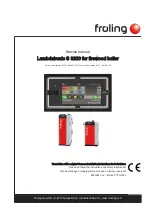
120
106375-01 - 4/16
XII. Operation
F. Changing Adjustable Parameters (continued)
“Press”
button to access the following parameters:
Factory
Setting Range / Choices
Parameter and Description
180°F
(82.2°C)
60°F to 190°F
(16°C to 87.8°C)
Central Heat Setpoint
Target temperature for the central heat priority. Value also used by the outdoor air reset function.
10°F
(5.6°C)
2°F to 25°F
(1.1°C to 14°C)
Central Heat Diff Above
The boiler stops when the water temperature rises ‘Diff Above’ degrees above the setpoint.
NOTE
Never set the Diff Above such that the Setpoint plus the ‘Diff Above’ is greater than 200°F. the
result may be nuisance manual reset hard lockouts. For example, if the setpoint is 180°F, the
maximum ‘Diff Above’ is 20°F. Further, if the setpoint is 190°F, the maximum ‘Diff Above’ is 10°F.
5°F
(2.8°C)
2°F to 25°F
(1.1°C to 14°C)
Central Heat Diff Below
The boiler starts when the water temperature drops ‘Diff Below’ degrees below the setpoint.
3
1 to 5
Response Speed
This parameter adjusts the Central Heat temperature controller Proportion Integral Derivative
(PID) values. Higher values cause a larger firing rate change for each degree of temperature
change. If set too high firing rate “overshoots” required value, increases to high fire causing the
temperature to exceed the “Diff Above” setpoint and cycle the boiler unnecessarily. Lower values
cause a smaller firing rate change for each degree of temperature change. If set too low, the firing
rate response will be sluggish and temperature will wander away from setpoint.
120
seconds 0 to 300 seconds
Low Fire Hold Time
“Low Fire Hold Time” is the number of seconds the control will wait at low fire modulation rate
before being released to modulate. After ignition and flame stabilization periods the firing rate is
held at low fire for “Low Fire Hold Time”. This delay allows heat to travel out to the system and
provide system feedback prior to the control modulating firing rate.
Supply
Sensor
Supply Sensor,
Header Sensor
Modulation Sensor
Heat Demand may respond to the boiler’s Supply Temperature or Header Temperature sensors.
When Header Sensor is selected the boiler is fired in response to the sensor wired to Header
Sensor Low Voltage Terminal Block Terminals.
















































